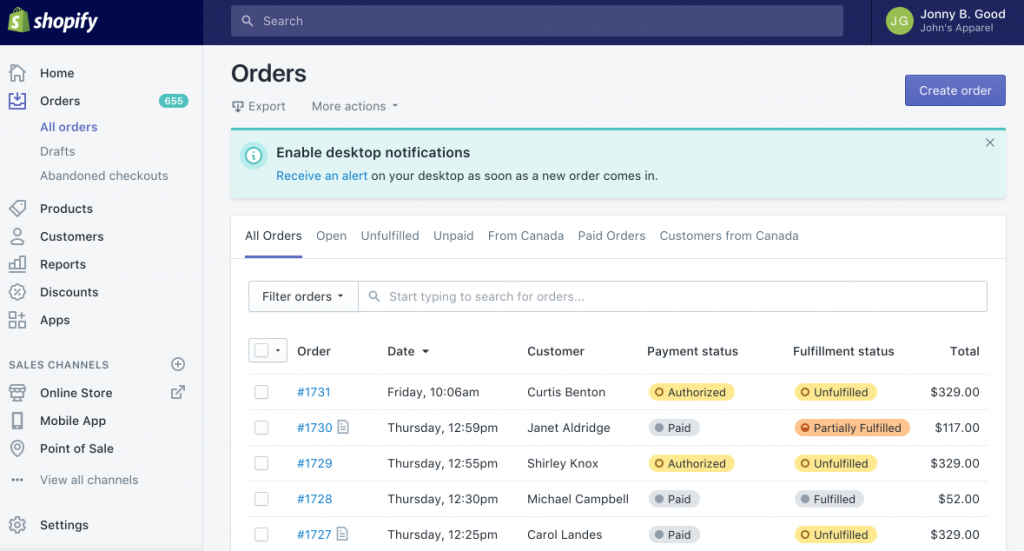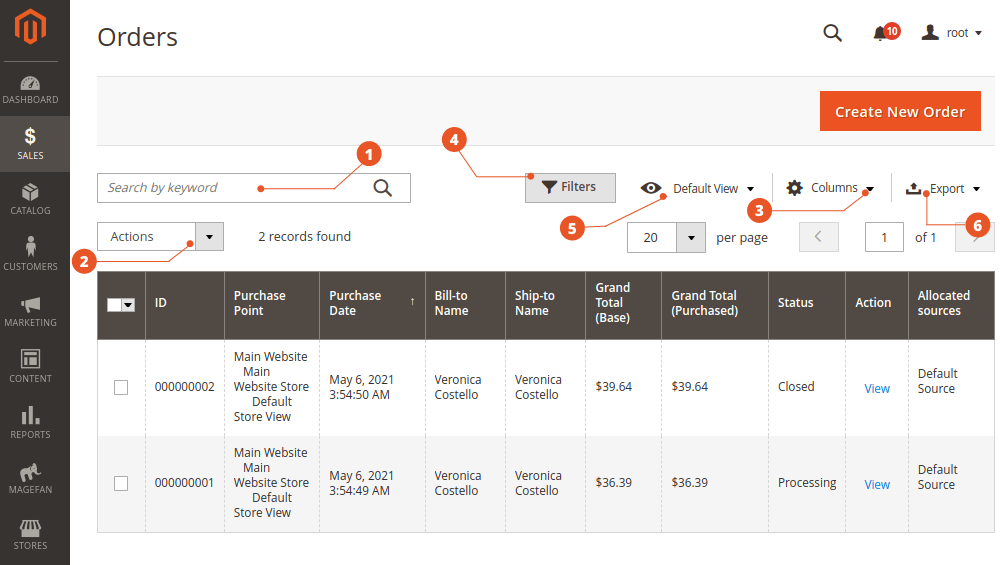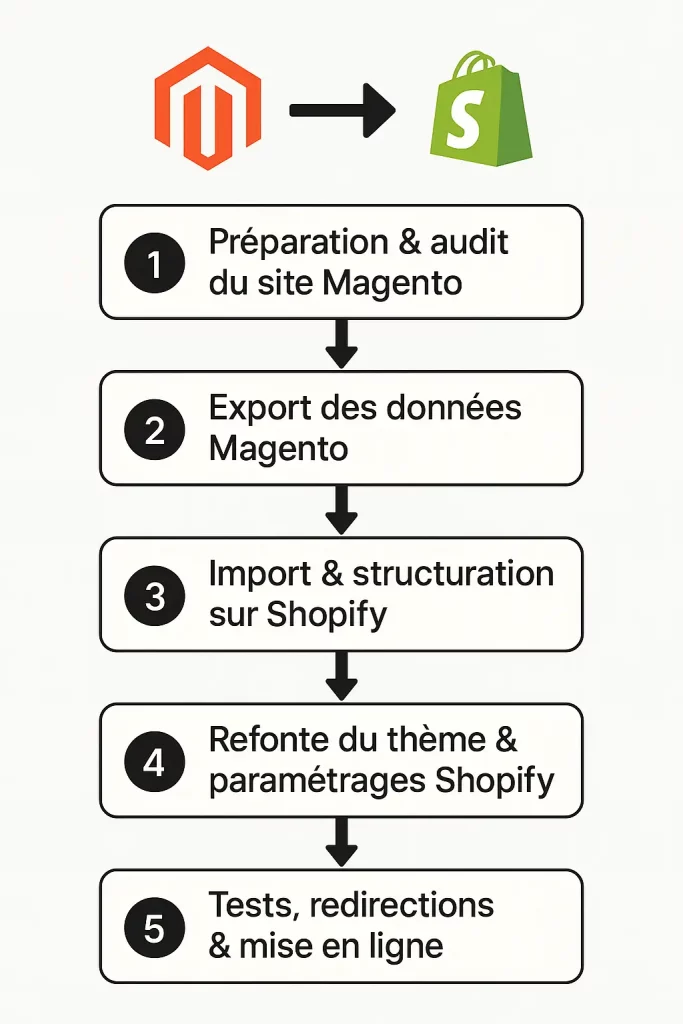The choice of an e-commerce platform determines the success of your online store. Shopify and Magento dominate the market with different approaches. This detailed comparison helps you make the right decision based on your specific needs.
What is Shopify?

Shopify is a SaaS e-commerce platform launched in Canada in 2006. It allows you to create an online store without technical skills. The solution hosts your site and manages the technical infrastructure.
Over 4.5 million stores worldwide use Shopify. The platform generates over $444 billion in annual sales. Brands like Gymshark, Allbirds, and Heinz trust this solution.
Shopify operates on a monthly subscription model. You pay for access to the platform, hosting, and features. Everything is included in your plan.
What is Magento?

Magento is an open-source e-commerce platform created in 2008. Adobe acquired the solution in 2018 and now offers it under the name Adobe Commerce.
The platform exists in two main versions. Magento Open Source is free and requires your own hosting. Adobe Commerce is the paid version with technical support and advanced features.
Over 250,000 merchants use Magento. Companies like Ford, Coca-Cola, and Nike leverage this technology. The solution represents 30% of the e-commerce platform market.
Ease of Use: Shopify Simplifies, Magento Customizes
Interface and Getting Started
Shopify offers an intuitive interface accessible to beginners. The setup wizard guides each creation step. You can launch your store in a few hours without touching any code.
The dashboard centralizes all essential functions. Product, order, and customer management is performed from a single interface. Visual modifications use a drag-and-drop system.
Magento requires technical skills for installation and configuration. The learning curve is longer. Developers appreciate the full flexibility of the source code.
Daily Management
Shopify automates repetitive tasks. Updates are installed automatically. Data backup occurs without intervention. SSL certificates renew automatically.
Magento requires regular maintenance. You manage updates manually. Backups require specific configuration. Security remains your responsibility.
Price Comparison: Initial Investment and Hidden Costs
Shopify Pricing

Shopify offers four main plans (prices shown reflect monthly, not annual, billing):
Basic Shopify at €36 monthly is suitable for small businesses. You manage up to 1,000 inventory locations. Two staff accounts are included.
Shopify at €105 per month meets the needs of growing businesses. Transaction fees are 2.6% + €0.25. Five staff accounts are available.
Advanced Shopify costs €399 monthly. Transaction fees decrease to 2.4% + €0.25. Fifteen staff accounts access the system.
Shopify Plus starts at €2,000 per month. This enterprise solution is suitable for large brands. Price negotiation is possible depending on volume.
Magento Costs
Magento Open Source is free. You only pay for hosting, domain name, and extensions. A high-performance server costs between €50 and €500 monthly depending on traffic.
Adobe Commerce requires a custom quote. Prices range from $22,000 to $125,000 annually. The price depends on revenue and required features.
Adobe Managed Service adds full technical support. Prices significantly exceed Adobe Commerce Pro. This offer targets large accounts only.
Additional Costs
Shopify charges transaction fees on sales. Using third-party gateways incurs additional costs of 0.5% to 2%. Paid applications increase the monthly bill.
Magento requires a development investment. A developer costs between €50 and €150 per hour. Premium extensions add one-time or recurring fees. Technical maintenance represents a significant budget.
| Cost Elements | Shopify | Magento (Open Source / Adobe Commerce) |
|---|---|---|
| Base Price | €36 to €399/month (Shopify Plus from €2,000/month) | Free (Open Source) / $22,000 to $125,000/year (Adobe Commerce) |
| Hosting | Included in all plans | €50 to €500/month depending on server and traffic |
| Development | Optional (€0 if standard theme) / €50–€150/hr for external devs | Often essential / €50–€150/hr for Magento developers |
| Applications / Extensions | €0 to €300/month per app | Free to €3,000+ per extension |
| Technical Maintenance | Included (updates, security, SSL) | €200 to €2,000/month depending on needs |
| Transaction fees | 0% with Shopify Payments / 0.5% to 2% with third-party gateway | Depends on the chosen payment provider (Stripe, PayPal…) |
| Estimated Total Annual Cost (small store) | €400 to €3,000 | €1,500 to €8,000 |
| Estimated Total Annual Cost (advanced site) | €5,000 to €25,000 | €20,000 to €150,000 |
Design and Customization: Templates vs. Custom Development
Available Themes
Shopify offers 10 free themes and 64 premium themes. Paid templates cost between $140 and $180. Each theme is mobile-optimized and adheres to current web standards.
Magento offers 11 themes in its official library. Prices range from $17 to $400. Thousands of third-party templates exist on external marketplaces.
Visual Customization
Shopify limits modifications to the chosen theme’s framework. The visual editor allows adjustments without coding. Developers access Liquid code for in-depth changes.
Magento allows for total customization. You can modify every aspect of the design. Developers create unique themes from scratch. Creative freedom remains limitless.
Responsive Design
All Shopify themes are responsive by default. The display automatically adapts to screens. Google favors these sites in mobile search results.
Magento requires responsive design verification. Some older themes lack mobile optimization. Developers must test on different devices.
E-commerce Features: Integrated Sales Tools
Product Management
Shopify manages unlimited catalogs. CSV import facilitates bulk addition. Product variants are easily created. Automatic collections organize inventory.
Magento excels in complex catalog management. Custom attributes offer total flexibility. Dynamic pricing rules adapt to customer segments. Multi-warehouse management is native.
Order Process
Shopify checkout occurs on a single page. Conversion increases with this simplified process. Shop Pay accelerates payment for regular customers.
Magento offers a customizable checkout. You can adapt each step according to your needs. B2B options include quotes and complex orders.
Inventory management
Shopify tracks inventory in real-time. Alerts prevent stockouts. Multi-channel synchronization prevents overselling.
Magento offers advanced inventory management. Multiple sources are managed natively. Intelligent allocation optimizes shipments. Forecasts help anticipate needs.
Payment Methods: Flexibility and Transaction Fees
Integrated Gateways
Shopify Payments simplifies payment acceptance. Over 100 third-party gateways are available. Additional fees apply outside of Shopify Payments.
Magento integrates all major gateways without additional fees. PayPal, Stripe, and Braintree function natively. Local solutions are easily added.
Payment Methods
Shopify accepts cards, wallets, and deferred payments. Cryptocurrencies require third-party applications. Installment payments are available.
Magento supports all imaginable payment types. B2B transfers are native. Invoice solutions are suitable for professionals.
Transaction Security
Shopify is PCI DSS Level 1 certified. SSL encryption protects all data. Fraud detection is automatic.
Magento requires your own PCI compliance. Security measures depend on your configuration. Security extensions enhance protection.
Extensions and Applications: each Platform’s Ecosystem
App Marketplace
The Shopify App Store contains over 8,000 applications. Categories cover marketing, logistics, and accounting. Installation is done with one click from the interface.
The Magento Marketplace offers 5,700 extensions. Modules cover all aspects of e-commerce. Installation often requires developer intervention.
Quality and Price
Shopify applications undergo a strict validation process. Prices range from free to several hundred euros monthly. Monthly subscriptions dominate the economic model.
Magento extensions vary greatly in quality. Prices range from free to several thousand euros. Perpetual licenses remain common.
Native Integrations
Shopify integrates natively with major tools. Google, Facebook, and Amazon connect directly. Popular ERP and CRM systems have official connectors.
Magento often requires modules for integrations. Adobe Experience Cloud integrates seamlessly. Enterprise systems require custom development.
SEO and Search Engine Optimization: Magento vs. Shopify for Google Ranking
Basic SEO Features
Shopify automatically generates XML sitemaps. Canonical tags prevent duplicate content. Metadata can be customized for each page. URLs are optimized by default.
Magento offers total control over technical SEO. 301 redirects are finely managed. The robots.txt file is customizable. Rich snippets are easily implemented.
Performance and Speed
Shopify uses a global CDN for speed. Caching is managed automatically. Core Web Vitals are optimized by default. Image lazy loading is native.
Magento requires manual performance optimization. Caching requires specific configuration. A CDN must be added separately. Image optimization remains your responsibility.
SEO Applications
Shopify offers 120 SEO applications in its store. The tools cover auditing, optimization, and tracking. Prices remain affordable for most.
Magento offers over 400 SEO extensions. Features range from basic to enterprise. Professional solutions cost several thousand euros.
Support and Assistance: Guidance vs. Community
Official Support
Shopify provides 24/7 support via chat, email, and phone. Support is available in French. Comprehensive documentation covers all topics. Video tutorials facilitate learning.
Magento Open Source does not include official support. Documentation exists primarily in English. Users rely on the community. Adobe Commerce includes dedicated technical support.
Community Resources
The Shopify community remains modest but active. Official forums answer common questions. Facebook groups share tips and tricks.
The Magento community is massive and technical. Stack Overflow is full of solutions. Local meetups create connections. Open-source contributors constantly improve the platform.
Training and Certification
Shopify Academy offers free online courses. Shopify Partner certifications validate expertise. Regular webinars present new features.
Magento offers recognized technical certifications. Official training courses cost several thousand euros. Certified developers command premium rates.
Scalability: Growth and Limitations of each Solution
Processing Capacity
Shopify Plus handles up to 10,000 transactions per minute. The infrastructure automatically adapts to peaks. Black Friday poses no technical issues.
Magento scales according to your infrastructure. A powerful server processes millions of orders. Limitations depend on your hosting budget.
Multi-Store Management
Shopify requires a subscription per store. Centralized management requires Shopify Plus. Costs increase rapidly with multiple sites.
Magento natively manages multiple stores from one installation. Sites share a catalog and customers. Administration remains centralized.
International and Multilingual
Shopify Markets facilitates international sales. Currencies and languages are managed simply. Taxes adjust automatically by country.
Magento excels in international commerce. Multilingual sites are native. Country-specific configurations are unlimited.
Prestashop vs Shopify vs Magento vs WooCommerce: Expanding the Comparison
Market Position
WooCommerce dominates with 39% market share. This WordPress extension remains free. Small stores favor this economical solution.
Shopify holds 10% of the global market. Growth remains constant year after year. New stores are massively choosing this platform.
Magento represents 6% of e-commerce sites. Large enterprises maintain their trust. Adobe invests heavily in innovation.
PrestaShop occupies 5% of the market, primarily in Europe. The French solution appeals to SMEs. The open-source approach attracts developers.
Compared Costs
WooCommerce requires WordPress, a theme, and plugins. The budget starts at €500 for a basic site. Costs increase with needs.
PrestaShop is free in its basic version. Paid modules accumulate quickly. A professional site costs between €3,000 and €15,000.
Technical Complexity
WooCommerce remains accessible with WordPress knowledge. Updates require vigilance. Conflicts between plugins cause issues.
PrestaShop lies between Shopify and Magento in complexity. Installation remains simple. Customization requires PHP development.
Magento vs OpenCart vs Shopify: Open-Source Alternatives
OpenCart in the Equation
OpenCart offers a lightweight open-source solution. The administration interface remains intuitive. Over 13,000 extensions enhance its features.
The OpenCart community has 360,000 members. Support remains primarily English-speaking. French resources are limited.
Technical Comparison
OpenCart consumes fewer resources than Magento. Shared hosting is sufficient to start. Performance remains adequate for up to 10,000 products.
Magento surpasses OpenCart in native features. B2B management is more mature. Large catalogs are managed better.
Shopify eliminates all technical considerations. You can focus on sales. Technical limitations do not exist.
Appropriate Use Cases
OpenCart is suitable for simple stores with a tight budget. PHP developers appreciate the clear structure. Custom projects develop quickly.
Magento meets the complex needs of large enterprises. B2B features are unparalleled. The investment is justified by volume.
Security and Compliance: Customer Data Protection
Security Measures
Shopify fully manages your store’s security. Patches are applied automatically. Monitoring detects intrusion attempts. Automatic backups protect your data.
Magento makes you responsible for security. Updates must be applied promptly. Third-party extensions create vulnerabilities. Regular auditing remains essential.
GDPR Compliance
Shopify provides GDPR compliance tools. Customer data can be easily deleted. Consents are managed natively.
Magento requires extensions for full compliance. Developers implement GDPR features. Legal responsibility rests with you.
Certificates and Standards
Shopify is PCI DSS Level 1 certified. SOC 2 Type II compliance is achieved. ISO 27001 standards are met.
Magento requires your own PCI certification. Security audits remain your responsibility. Cyber risk insurance becomes necessary.
Platform Migration: Moving from one to Another
From Magento to Shopify
If you are already using Magento but are experiencing technical limitations or a need for simplification, you might consider a Magento to Shopify migration to benefit from smoother management, more predictable costs, and a fully hosted environment. Here is what the simplified process looks like:

Migration requires careful planning. Product data is exported in CSV format. Customer histories are transferred via API. URLs must be properly redirected.
Applications like Cart2Cart automate the process. The cost varies depending on the data volume. Expect between €500 and €5,000 for a complete migration.
From Shopify to Magento
This migration is technically more complex. Magento developers manage the transfer. Shopify customizations do not automatically replicate.
The budget starts at €5,000 for a basic migration. Complex projects exceed €20,000. Migration time can extend to several weeks.
Minimize Impact
Plan the migration during the off-season. Test thoroughly before launch. Keep the old site temporarily accessible. Communicate clearly with your customers.
Use Cases and Final Recommendations
Choose Shopify if:
You are new to e-commerce without technical skills, or you desire an easy all-in-one solution that adapts to your growth. Your budget remains limited but predictable. Speed of launch is paramount. You primarily sell B2C. Technical support remains crucial for you.
Prefer Magento when:
You have complex specific needs. The budget allows for investment in development. A technical team manages the platform. B2B is your core target. Total customization is essential.
Decisive Factors
The total budget, including hidden costs, guides your choice. Available in-house skills influence the decision. The complexity of your catalog points towards a solution. Growth ambitions determine the necessary scalability.
Frequently Asked Questions
How Do I Know if My In-House Team is Better Suited for Shopify or Magento?
If your team does not have a dedicated developer or already works with SaaS tools, Shopify is generally more suitable. Conversely, if you have an in-house developer or a service provider accustomed to PHP and complex environments, Magento becomes a more natural choice. The key indicator: your ability to manage updates, security, and customizations without hindering business operations.
Which Platform Offers the Best Cost Control over 3 to 5 Years?
Shopify is more predictable because costs are primarily monthly. Magento may be cheaper initially (Open Source) but becomes more expensive with hosting, maintenance, and continuous development. For a stable budget, Shopify is safer; for a flexible budget geared towards custom development, Magento can be profitable in the long term.
Which Solution is Best Suited if I Need to Connect a Complex ERP, PIM, or CRM?
Both platforms allow this, but not at the same level. Shopify is suitable if your system already has an existing connector. Magento becomes preferable when your workflows are highly customized or you need to manage complex business rules, as it allows fine control over the integration logic.
Which Platform is Best for Managing Multiple Catalogs with Different Rules?
For simple or medium catalogs, Shopify performs very well through its collections and specialized applications. As soon as your rules become advanced (pricing per client, catalogs per country, B2B restrictions, complex variations), Magento offers complex possibilities. The decisive criterion: the complexity of the rules, not the raw catalog size.
When should I Consider a Migration rather than Optimizing My Current Platform?
A migration is relevant if you are limited by structural roadblocks: chronic slowness despite optimization, inability to add essential functions, excessively high maintenance costs, or growth hindered by technology. If your issues are more related to design, content, marketing, or technical optimization, it is often more cost-effective to improve your current site.
Conclusion
Shopify and Magento excel in different contexts. Shopify democratizes e-commerce with simplicity and reliability and adapts to all types of stores. Magento offers power and flexibility for large-scale projects.
Your choice depends on your business priorities. Honestly assess your resources and skills. Anticipate your future needs before deciding. Both platforms have proven their worth in the market.
Migration remains possible if you change your mind. Starting with Magento and then migrating to Shopify is logical as you grow and wish to maintain a simplicity-based approach. The reverse is suitable for businesses seeking an evolution towards B2B.
Test both solutions before final commitment. Shopify offers a 14-day free trial. Magento Open Source can be installed for free for evaluation. Your personal experience will validate the right choice.



